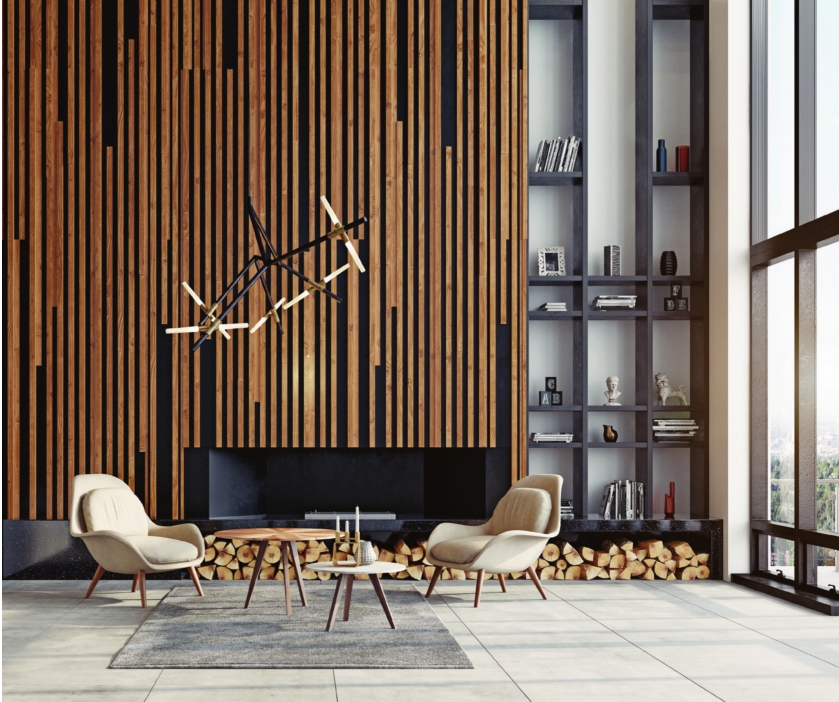
WHILE SLICK SYNTHETICS WERE BIG IN INTERIOR DESIGN, NATURAL WOODS ARE RETURNING
Picture a contemporary home – what comes to mind? Is it tall ceilings, big windows, clean lines? Certainly, but also an overriding feature in recent design has been stark, stark and starker. White walls, off-white window coverings, stonework and marble everywhere. While the clean look can be beautiful and neat, an increasing trend in design is to incorporate more visual variety and pop into built-in surfaces. In many cases, it’s the timeless beauty of natural-grained wood.
While wood doors, cabinetry and even frame components can harken unpleasantly back to the “country clutter” or “log cabin” styles of yesteryear, modern designers are utilizing both different starting points and different materials to create beauty in a room. Drawing inspiration from the boxed, clean, long-grain lines of resurgent Mid-Century Modern, the results are often more subtle than a knotty pine, overly ornate kitchen cabinet – think more “Danish Modern teak” than “Paul Bunyan oak.”
The result is a kitchen, or a bathroom, or even a walk-in closet that retains the freeing openness that synthetic or stone would offer, coupled with a finish that is more in tune with nature’s symmetry and perfect imperfection. Long, straight grains with few knots are often book-matched on larger surfaces, such as doors or cabinet fronts, with the bilateral symmetry creating eye-catching repetitions and a sense of purposeful design. Bleached, darker woods give uniquity to lumber-like walnut, which otherwise may seem too imposing in a light, airy Southern California space. And exotic-yet-sustainable varieties abound, so your carbon footprint needn’t extend to your home.
Among the venerable woods sustainably in use these days are birch and maple. From our own backyards and used for centuries in U.S. furniture making, they are naturally light hardwoods with a hint of sheen and interesting imperfections that make for beautiful surfaces without requiring veneer. Highly durable, those fast-growing trees are farmed in the U.S. and Canada specifically for cabinetry and furniture production.
Among mindfully sourced international lumber, acacia remains king. Able to be quickly grown and amenable to commercial farming, acacia has come to replace overharvested teak wood almost fully in all but high-moisture outdoor applications. With a beautiful, medium-brown grain, black striations and long, clean lines, the hardwood can be used to complement anything, from cabinetry, shelving, blinds, and even wooden bowls and cups.

Another increasingly popular wood for use in cabinetry– especially in kitchens and bathrooms – is bamboo. While it’s been used for years, this isn’t the bamboo reed that adorned many 1950s Polynesian-inspired rumpus rooms and theme bars: It’s more timeless than Tiki. The readily sourced wood, grown everywhere and at lightning speeds, has been used to create gorgeous, golden-brown facing surfaces at home in beach cottages or luxuriously appointed bathrooms. Given its ease of growth, it’s also inexpensive, so a bamboo makeover won’t breaka budget.
While these abundant woods are perfect for wide use for a pop of color, as a finish on a cap or a contrasting tone, opt for “exotics.” The quotes, of course, denote that these beautiful, rare-looking woods are still considered among the sustainable hardwoods, many sourced right here in the U.S. Osage Orange, a midwestern wood (which is, in fact, more closely related to the apple tree) produces a high-sheen and exceptionally durable wood that can be used to set off endcaps or other detail work. Black Locust, another plant endemic to the U.S. but now increasingly cultivated worldwide, offers a beautiful, durable grain that needs minimal preservation to offer beauty – perfect to create a live-edge and enhance any room witha naturalistic detail.